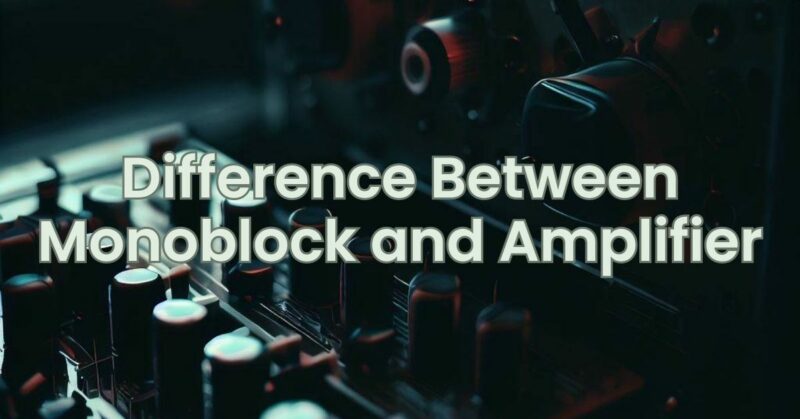When it comes to audio amplification, two common configurations are monoblock amplifiers and stereo amplifiers. Both types serve distinct purposes and have their own unique characteristics. Understanding the differences between monoblock and stereo amplifiers is essential in choosing the right amplifier for your audio system. In this article, we will delve into the distinctions between monoblock and stereo amplifiers to help you make an informed decision.
Monoblock Amplifier: Dedicated Power and Channel
A monoblock amplifier, as the name suggests, consists of a single amplifier channel dedicated to driving a single speaker or audio source. Monoblock amps are designed for high power output, typically used for applications where maximum power is required, such as driving subwoofers or individual high-performance speakers.
The primary advantage of a monoblock amplifier is its ability to deliver dedicated power to a single channel. By focusing all the amplifier’s resources on a single audio channel, a monoblock amp can provide high levels of power and current, resulting in dynamic and precise audio reproduction. This dedicated power delivery ensures optimal performance and allows for better control over the speaker or audio source being driven.
Stereo Amplifier: Dual Channels for Balanced Audio
A stereo amplifier, also known as a two-channel amplifier, features two independent amplifier channels, typically used for driving a pair of speakers or audio sources. Stereo amps are commonly used in stereo audio systems, home theater setups, and music listening environments.
The main advantage of a stereo amplifier is its ability to provide a balanced audio experience. With two independent channels, a stereo amp can deliver separate audio signals to the left and right speakers, creating a wider soundstage and enhanced stereo imaging. This allows for a more immersive listening experience, particularly in applications where stereo separation and spatial accuracy are crucial.
Stereo amplifiers are versatile and can accommodate a variety of audio sources, including CD players, turntables, and media players. They provide a balanced amplification solution for stereo audio reproduction and are suitable for applications where stereo imaging and soundstage are important factors.
Key Differences between Monoblock and Stereo Amplifiers
- Channel Configuration: Monoblock amplifiers have a single channel dedicated to a single speaker or audio source, while stereo amplifiers feature two independent channels for driving a pair of speakers or audio sources.
- Power Output: Monoblock amps are designed for high power output, delivering substantial power to a single channel. Stereo amplifiers distribute power between two channels, typically with equal power output to both channels.
- Application: Monoblock amplifiers are commonly used in scenarios where high power is required for specific speakers or audio sources, such as subwoofers. Stereo amplifiers are suitable for stereo audio systems, home theaters, and other applications where balanced audio reproduction is desired.
- Stereo Imaging: Stereo amplifiers provide a wider soundstage and improved stereo imaging due to the separate amplification of left and right audio channels. Monoblock amplifiers are not specifically focused on stereo imaging but excel in delivering power and control to a single channel.
Here is a table that summarizes the key differences between monoblock and amplifier:
| Feature | Monoblock | Amplifier |
|---|---|---|
| Number of channels | 1 | 2 or more |
| Power output | More powerful | Less powerful |
| Bass response | Deeper bass | Shallower bass |
| Price | More expensive | Less expensive |
| Installation | More difficult | Easier |
Choosing the Right Amplifier for Your Needs
Selecting the appropriate amplifier configuration depends on your specific audio requirements and the intended application. Consider the following factors when deciding between a monoblock and stereo amplifier:
- Power Needs: Determine if you require high power output for specific speakers or if balanced power distribution between left and right channels is more important.
- Application: Assess the purpose of your audio system. If you need dedicated power for a single speaker or audio source, a monoblock amplifier may be the better choice. If stereo imaging and balanced audio reproduction are essential, a stereo amplifier is more suitable.
- Speaker Configuration: Consider the number and type of speakers you plan to use. Monoblock amplifiers are typically used for single speakers, such as subwoofers, while stereo amplifiers are designed for stereo configurations.
- Budget and Future Expansion: Take into account your budget constraints and future expansion plans. Monoblock amplifiers tend to be more expensive but offer dedicated power, while stereo amplifiers provide versatility and potential for expanding to a multi-channel system.
Conclusion
Understanding the differences between monoblock and stereo amplifiers is crucial in selecting the right amplifier configuration for your audio needs. Monoblock amplifiers provide dedicated power and control to a single channel, making them suitable for high-power applications like subwoofers. Stereo amplifiers offer balanced audio reproduction, wider soundstage, and enhanced stereo imaging, making them ideal for stereo audio systems and home theaters. Consider your power requirements, application, speaker configuration, budget, and future expansion plans to make an informed decision that aligns with your audio goals.


